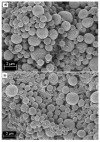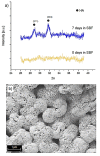Integration of Mesoporous Bioactive Glass Nanoparticles and Curcumin into PHBV Microspheres as Biocompatible Composite for Drug Delivery Applications
- PMID: 34073377
- PMCID: PMC8198669
- DOI: 10.3390/molecules26113177
Integration of Mesoporous Bioactive Glass Nanoparticles and Curcumin into PHBV Microspheres as Biocompatible Composite for Drug Delivery Applications
Abstract
Bioactive glasses (BGs) are being increasingly considered for biomedical applications. One convenient approach to utilize BGs in tissue engineering and drug delivery involves their combination with organic biomaterials in order to form composites with enhanced biocompatibility and biodegradability. In this work, mesoporous bioactive glass nanoparticles (MBGN) have been merged with polyhydroxyalkanoate microspheres with the purpose to develop drug carriers. The composite carriers (microspheres) were loaded with curcumin as a model drug. The toxicity and delivery rate of composite microspheres were tested in vitro, reaching a curcumin loading efficiency of over 90% and an improving of biocompatibility of different concentrations of MBGN due to its administrations through the composite. The composite microspheres were tested in terms of controlled release, biocompatibility and bioactivity. Our results demonstrate that the composite microspheres can be potentially used in biomedicine due to their dual effects: bioactivity (due to the presence of MBGN) and curcumin release capability.
Keywords: PHBV; bioactive glass nanoparticles; composite microspheres; drug delivery systems.
Conflict of interest statement
The authors declare no conflict of interest.
Figures












Similar articles
-
Fabrication and Characterization of Cinnamaldehyde-Loaded Mesoporous Bioactive Glass Nanoparticles/PHBV-Based Microspheres for Preventing Bacterial Infection and Promoting Bone Tissue Regeneration.Polymers (Basel). 2021 May 29;13(11):1794. doi: 10.3390/polym13111794. Polymers (Basel). 2021. PMID: 34072334 Free PMC article.
-
Investigation of emulsified, acid and acid-alkali catalyzed mesoporous bioactive glass microspheres for bone regeneration and drug delivery.Mater Sci Eng C Mater Biol Appl. 2013 Oct;33(7):4236-43. doi: 10.1016/j.msec.2013.06.022. Epub 2013 Jun 26. Mater Sci Eng C Mater Biol Appl. 2013. PMID: 23910338
-
Fabrication and characterization of hydroxyapatite/sodium alginate/chitosan composite microspheres for drug delivery and bone tissue engineering.Mater Sci Eng C Mater Biol Appl. 2019 Jul;100:576-583. doi: 10.1016/j.msec.2019.03.040. Epub 2019 Mar 11. Mater Sci Eng C Mater Biol Appl. 2019. PMID: 30948094
-
Zein-based composites in biomedical applications.J Biomed Mater Res A. 2017 Jun;105(6):1656-1665. doi: 10.1002/jbm.a.36040. Epub 2017 Mar 27. J Biomed Mater Res A. 2017. PMID: 28205372 Review.
-
Bioactive Glass and Silica Particles for Skeletal and Cardiac Muscle Tissue Regeneration.Tissue Eng Part B Rev. 2024 Aug;30(4):448-461. doi: 10.1089/ten.TEB.2023.0277. Epub 2024 Feb 20. Tissue Eng Part B Rev. 2024. PMID: 38126329 Review.
Cited by
-
Zn-Mn-Doped Mesoporous Bioactive Glass Nanoparticle-Loaded Zein Coatings for Bioactive and Antibacterial Orthopedic Implants.J Funct Biomater. 2022 Jul 16;13(3):97. doi: 10.3390/jfb13030097. J Funct Biomater. 2022. PMID: 35893465 Free PMC article.
-
Engineering mesoporous bioactive glasses for emerging stimuli-responsive drug delivery and theranostic applications.Bioact Mater. 2024 Jan 12;34:436-462. doi: 10.1016/j.bioactmat.2024.01.001. eCollection 2024 Apr. Bioact Mater. 2024. PMID: 38282967 Free PMC article. Review.
-
Comparison between the Astaxanthin Release Profile of Mesoporous Bioactive Glass Nanoparticles (MBGNs) and Poly(3-hydroxybutyrate-co-3-hydroxyvalerate) (PHBV)/MBGN Composite Microspheres.Polymers (Basel). 2023 May 24;15(11):2432. doi: 10.3390/polym15112432. Polymers (Basel). 2023. PMID: 37299231 Free PMC article.
-
Enhancing alginate dialdehyde-gelatin (ADA-GEL) based hydrogels for biofabrication by addition of phytotherapeutics and mesoporous bioactive glass nanoparticles (MBGNs).J Biomater Appl. 2025 Jan;39(6):524-556. doi: 10.1177/08853282241280768. Epub 2024 Sep 21. J Biomater Appl. 2025. PMID: 39305217 Free PMC article.
-
Fabrication and Characterization of Cinnamaldehyde-Loaded Mesoporous Bioactive Glass Nanoparticles/PHBV-Based Microspheres for Preventing Bacterial Infection and Promoting Bone Tissue Regeneration.Polymers (Basel). 2021 May 29;13(11):1794. doi: 10.3390/polym13111794. Polymers (Basel). 2021. PMID: 34072334 Free PMC article.
References
-
- Zafar M.S., Farooq I., Awais M., Najeeb S., Khurshid Z., Zohaib S. Biomedical, Therapeutic and Clinical Applications of Bioactive Glasses. Elsevier; Amsterdam, The Netherlands: 2019. Bioactive Surface Coatings for Enhancing Osseointegration of Dental Implants; pp. 313–329.
-
- Ballarre J., Aydemir T., Liverani L., Roether J., Goldmann W., Boccaccini A. Versatile bioactive and antibacterial coating system based on silica, gentamicin, and chitosan: Improving early stage performance of titanium implants. Surf. Coat. Technol. 2020;381:125138. doi: 10.1016/j.surfcoat.2019.125138. - DOI
-
- Doğrul F., Bernardo E., Boccaccini A.R., Galusek D. FunGlass School 2019/Part 1. Trencin, Slovaki: 2019. [(accessed on 18 May 2021)]. Production of SiOC Based Bioactive Glass for Bone-Tissue Applications. Available online: https://www.funglass.eu/wp-content/uploads/2019/05/FunGlass-School-2019-....
-
- Penide J., Quintero F., del Val J., Comesaña R., Lusquiños F., Riveiro A. Chapter 10-Bioactive glass nanofibers for tissue engineering. In: Grumezescu V., Grumezescu A.M., editors. Materials for Biomedical Engineering. Elsevier; Amsterdam, The Netherlands: 2019. pp. 329–356.
MeSH terms
Substances
Grants and funding
LinkOut - more resources
Full Text Sources

